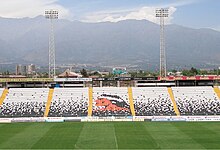Estadio Monumental (Santiago de Chile)
| Estadio Monumental David Arellano | |
|---|---|
| El Coloso de Pedreros La Ruca |
|

|
|
| Cordillera sector | |
| Data | |
| place | Av. Marathon 5300 Macul , Santiago de Chile |
| Coordinates | 33 ° 30 ′ 24 ″ S , 70 ° 36 ′ 21 ″ W |
| owner | CSD Colo-Colo |
| start of building | 1956 |
| opening | April 20, 1975 September 30, 1989 (reopening) |
| First game | April 20, 1975 CD Santiago Morning - CD Santiago Wanderers 1: 1 |
| surface | Natural grass |
| architect | Mario Recordón |
| capacity | 47,000 seats |
| playing area | 105 × 68 m |
| Societies) | |
| Events | |
|
|
The Estadio Monumental , or El Monumental for short , is a football stadium in the Macul district southeast of the center of the Chilean capital Santiago and is owned by the CSD Colo-Colo football club . The stadium, for which the foundation stone was laid in 1956 and in which football competitions have been held regularly since 1989, has a capacity of 47,000 spectators. The field bears the name of David Arellano , the club's founder - which is why the stadium is often called the Estadio Monumental David Arellano .
The stadium is built into a dredged hole in the earth, which allows a view of the Andes from the main stand , the Sector Océano , behind the uncovered Cordillera stand in the east. Only the upper tiers of the main stand are covered. The pitch is only five meters from the stands.
The stadium area includes five other football fields, including one with artificial turf , on which the Colo-Colo teams train, accommodation for youth players in the so-called Casa Alba , which also houses facilities for conferences, and the club museum. The club's administration is located in the stadium.
From 1998 to 2011, the Chilean national soccer team played six games at the venue, all of which were won by the hosts with the exception of one tie.
The stadium was also used for various musical events.
history
In 1956, CSD Colo-Colo acquired 28 hectares of land with the intention of building a stadium for 120,000 spectators, which was also to be a main venue for the 1962 World Cup . Due to the great earthquake of 1960 , the government cut spending on new football stadiums and thus also this project. Only around 25% of the construction had been completed by then.
The completion took place only when the club had the necessary economic capacity, which was favored among other things by the sale of the player Carlos Caszely to the Spanish club UD Levante . On April 20, 1975, the stadium was inaugurated with a double event, which was attended by 25,599 spectators. First, CD Santiago Morning and CD Santiago Wanderers split 1: 1. In the following main act, Colo-Colo defeated CD Aviación 1-0. Carlos Orellana made a name for himself here as a goal scorer. However, the stadium still did not meet the requirements of regular game operations and Colo-Colo returned to the Estadio Nacional after only five more games .
Only after the honorary president of the club and then President of Chile, the dictator Augusto Pinochet , the club donated 300 million pesos from government funds and the resale of a player in 1987, this time by Hugo Rubio to the Italian FC Bologna , brought in further funds, could Colo-Colo complete the stadium construction. In the new inauguration game on September 30, 1989, Colo-Colo CA Peñarol from Uruguay defeated 2-1. Colo-Colos Marcelo Barticciotto scored the first goal of this era and Leonel Herrera secured the home side's victory with his goal to the final score. In January 1991 the floodlights of the stadium were inaugurated with a 1-0 victory over the Racing Club from Buenos Aires. On June 5 of the same year Colo-Colo celebrated the greatest triumph in the club's history in the same place, when the team defeated Club Olimpia from the Paraguayan capital Asunción 3-0 in the final second leg of the Copa Libertadores in 1991 and thus the trophy for the only time to date Chile took.
In that era, the stadium had an official capacity of 62,500 to 65,000 spectators. Record attendance was 69,305 viewers who watched a championship game between Colo-Colo and CD Universidad Católica in 1992 .
After various accidents, including one fatality in 1993, the Estadio Monumental underwent further modernizations such as the elimination of standing room and the installation of individual seats, which resulted in a reduction in capacity to 47,000 visitors. The fans in the corners still have to sit on concrete.
After a report by the world football association FIFA in 2006 found that no Chilean stadium meets their standards, the club is currently investigating further improvements to the stadium, such as roofing.
The CSD Colo-Colo is planning the modernization and expansion of the Estadio Monumental from 47,000 to 61,000 seats. 10,000 existing spaces with visual impairments would also have to be redesigned. This should happen with a view to the soccer world championship in 2030 on the 100th anniversary of the world tournament. Argentina, Chile, Paraguay and Uruguay are jointly planning to apply to host the World Cup.
Panoramic view
Web links
- The stadium on the club's website ( Memento of January 22, 2015 in the Internet Archive ) (Spanish)
- stadionwelt.de: Detailed picture gallery
Individual evidence
- ↑ History of the Estadio Monumental on the official website of the association ( Memento of April 1, 2013 in the Internet Archive ) (Spanish)
- ↑ Colo-Colo with expansion plans. In: stadionwelt.de. August 2, 2019, accessed August 9, 2019 .



